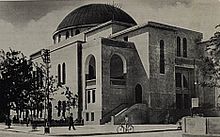Great Synagogue (Tel Aviv)
The Tel Aviv Great Synagogue is located at 110 Allenby Street, Tel Aviv , east of the Shalom Tower. The building was designed by Jehuda Magidovitch in 1922 and completed in 1926. It was renovated in 1970 with a new exterior facade with arches.
This Ashkenazi rite synagogue used to be in the center of Little Tel Aviv , but today the building is in the heart of the business and financial center. The emigration of local residents in the 1960s led to a significant reduction in the number of prayer participants in the Great Synagogue, so that the impressive building is now only used by a few parishioners who pray on public holidays and special occasions. In recent years, many public figures have decided to hold their Jewish wedding ceremonies in the synagogue.
History of the building
From 1912 a simultaneous Ashkenazi- Sephardic synagogue with two prayer rooms was planned for Tel Aviv , one for each of the two rites. In 1913 the foundation stone was laid for the construction of the synagogue on Yehuda Halevi Street. Construction was not carried out for various reasons, and in 1914 the synagogue committee held an open architectural competition to design the Great Synagogue on Allenby Street. The architect Richard Michael won this competition and also further developed the construction program for the synagogue. When the First World War broke out , the German Michael was drafted into the German army and forced to leave the country, which is why he did not complete the construction plans for the synagogue building. He was replaced by the also German architect Alexander Baerwald , who was also the planner for the Technion building in Haifa (1912), the Hebrew Reali School there (1912) and other private and municipal buildings in Tel Aviv. But the First World War thwarted the implementation.
After the 1921 pogroms against Jews in Jaffa, the British Mandate Administration granted Jaffa's suburb Tel Aviv, together with other suburban settlements mostly inhabited by Jews, the status of a township with a certain degree of autonomy within the Jaffa municipal association. The ten-member project committee for the construction of the synagogue, which had been formed in the meantime, decided to build a Great Synagogue of Ashkenazi ritual instead of two prayer rooms . The township council decided to finance the construction through a levy on all property owners.
When Tel Aviv's Sephardic Chief Rabbi Ben Zion ʿUsi'el learned of the changed plans for the Great Synagogue, he applied to the Tel Aviv Township Council to approve and collect a comparable levy for the construction of a Sephardic synagogue. The council refused, and Tel Aviv's deputy mayor told ʿUsi'el that the Ashkenazi Great Synagogue would be open to everyone after completion, and ʿUsi'el would then be familiar with the circumstances. ʿUsi'el objected, but without being met, and mobilized Sephardic landowners in the township to stop paying the levy for the Ashkenazi Great Synagogue . The council then relented and granted a grant for the city's Sephardic Great Synagogue .
In 1924 the foundation stone of the building on Allenby Street was laid according to the plans of the architect Jehuda Magidovitch . The construction of the synagogue building was delayed due to insufficient financial means until Baron Edmond Rothschild donated a large sum, through which the building could be continued in 1925 by the builder Samuel Nathan Wilson. The dome of the building was designed by the engineer Arpad Geuthe . The completed synagogue was inaugurated on April 9, 1930.
With the intention of reviving the synagogue and adapting it to its surroundings, the building was fundamentally rebuilt in 1969 according to the plans of the architect Arieh Elhanani , who added arches and cement columns to the building, thus transforming the building in the modern style. Changes were also made to the facade of the building, the furniture, the Torah shrine and the lighting.
The building has a huge dome, elaborate lighting fixtures and gorgeous stained glass windows . The stained glass windows are replicas of synagogue windows that were destroyed in Europe during the Holocaust .
The surroundings of the building
The planning of the area was carried out by architect Ze'ev Rechter in the late 1930s. Rechter planned an Italian-style square to encompass the north and east sides of the building. The square should have included a series of houses linked by a network of oriental arches to provide space for commercial shops.
This plan was only partially implemented, and among the planned houses, only the Beit Manny was built as planned.
Weapons store
After the bombing of the King David Hotel in 1946, British authorities found weapons stored in the synagogue's basement. As a result, the synagogue administrator Eliezer Neuman was arrested and sentenced to a year in prison by the military authorities.
Web links
http://www.tlvgreatsynagogue.org/English
Individual evidence
- ↑ Age Drujanow , סֵפֶר תֵּל אָבִיב , וַעֲדַת סֵפֶר תֵּל־אָבִיב (Ed.), Tel Aviv: הָעִירִיָּה, 5696 Jew. Kal. (9/28/1935– 9/16/1936) , p. 202.
- ↑ a b Rotem Erez, Planning and Injustice in Tel-Aviv / Jaffa: Urban segregation in Tel-Aviv's First Decades , Toronto, York Univ. Master thesis, June 7, 2016, p. 65seq.
- ↑ a b Anat Helman, Young Tel Aviv: a tale of two cities [הִתְגַּבְּשׁוּתָן שֶׁל חֶבְרֶה אֶזְרָחִית וְתַרְבּוּת עִירוֹנִית בְּתֵל־אָבִיב בִּשְׁנוֹת הָעֶשְׂרִים; Engl.], Haim Watzman (transl.), Waltham, Mass. and Hanover (NH): Brandeis University Press and University Press of New England, 2010, (= The Schusterman series in Israel studies), p. 140seq. ISBN 978-1-58465-893-1 .
- ^ Mordechai Naor , The Twentieth Century in Eretz Israel: A Pictorial History , [סֵפֶר הַמֵּאָה - הִיסְטוֹרְיָה מְצֻלֶּמֶת שֶׁל אֶרֶץ־יִשְׂרָאֵל, Tel Aviv: עַם עוֹבֵד, 1996; engl.], Cologne: Könemann, 1998, Judith Krausz (transl.), p. 163 and 165. ISBN 3-89508-595-2 .
- ^ Great Synagogue (The) . In: wcities.com . Retrieved February 4, 2009.
Coordinates: 32 ° 3 ′ 51.7 ″ N , 34 ° 46 ′ 20.1 ″ E

